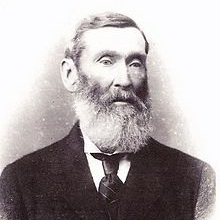On St. Patrick’s Day nobody ever pauses to consider the early struggles and rejection of Irishman Aeneas Coffey. He is, after all, the man who is credited with the commercial introduction of his patented continuous still, an innovation that would change the way whiskey is produced to this day. Coffey also set into motion an unstoppable chain of events that shaped the way whiskey is made and marketed to this day.

Aeneas Coffey was born in Dublin in 1780 and died in England on November 26, 1852. He was employed as a tax officer and was responsible for, among other things, closing illegal distilleries. As an Irish engineer, in 1831 he greatly improved the column still (also referred to as the Coffey, the Patent or the Continuous Still); a design which was initially developed by Robert Stein from Kilbagie in 1826.
This new technology made it possible for the first time to produce large quantities of whisky rapidly and cheaply. The upshot of employing Column Distillation is the ability to distill continuously rather in small batches which are labor intensive and time-consuming. The process is able to produce large volumes of alcohol at a much higher volume with almost any cereal grain.

The challenges of the Coffey distillation process, at least from the traditional perspective, are centered on the product it produces. Column stills will remove most of the fatty oils and unique flavor characteristics of the source grain which are prized by the distiller. Altering the heat level can neither change nor improve the flavor (1). The process produces a mainly flavorless grain alcohol. The end product from Aeneas Coffey’s still was rejected in the 1860’s by the market giants of Irish distillers as unauthentic and not true whiskey.
“The big four Dublin distilleries, serene in the knowledge that their long-established and aged-in-the-wood whiskey was beyond reproach, were for the first time jolted out of their complacency. They saw their hitherto unchallenged trading supremacy on the English market being breached and buffeted. Dublin pot still whiskey was being pushed aside and left unsold as an undiscerning public turned to a cheaper and spurious beverage, a kind of “instant whiskey.” (2)
1 Magee, M., & Magee, M. (1998). In Irish whiskey: A 1000 year tradition (p. 22). essay, O’Brien Press.
2 Magee, M., & Magee, M. (1998). In Irish whiskey: A 1000 year tradition (p. 32). essay, O’Brien Press.
The blending of Irish whiskey continued for decades with many articles, publications, and pamphlets produced in hopes of educating the public, but it was to little effect. In 1875 an amendment was introduced in the House of Commons to combat the practice. It was called the Adulteration of Food and Drugs Bill…which was killed by the Chancellor almost as soon as it was introduced. (3) It would be a long time before a similar bill would be passed.
It wasn’t until November, 1905 that the situation was first legally addressed with any success. Thomas Wells, a whiskey blender, was being sued in North London, accused of selling his blended product as “Irish whiskey” when it contained only ten percent Irish whiskey and ninety percent plain grain whiskey. He lost his case and paid a fine. But the decision in the case sent shockwaves of concern across the land.(4) After this case, labeling laws became progressively stricter and more closely enforced so that the consumer understood what exactly they were buying. It remained legal to blend whiskey, but the fact that it was blended had to be clearly stated, so that blended whiskey could not be misrepresented and sold as something else.
3 Magee, M., & Magee, M. (1998). In Irish whiskey: A 1000 year tradition (p. 31). essay, O’Brien Press.
4 Magee, M., & Magee, M. (1998). In Irish whiskey: A 1000 year tradition (pp. 39-41). essay, O’Brien Press.

But even if the Irish distillers mostly rejected the Coffey still, the Scottish embraced it. Coffey’s grain whisky was in many ways the basis for Diageo predecessor Distillers Company Limited eventually achieving its dominance, if not the entire Scotch whisky industry. (5)
In this month of March, let us raise a toast to Aeneas Coffey, the Irishman who revolutionized whiskey distillation for the entire industry!




